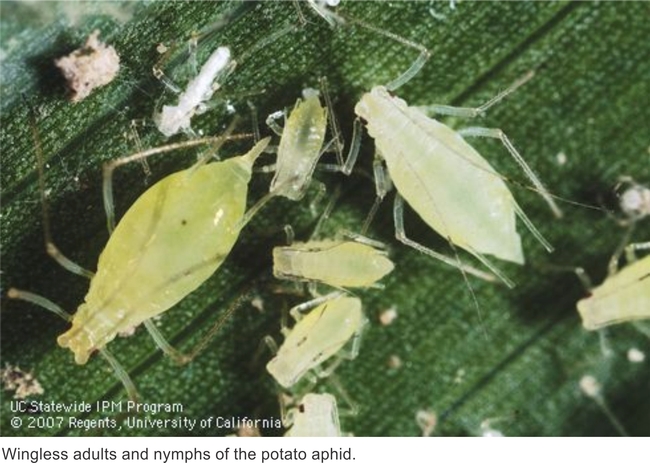
Low to moderate numbers of leaf-feeding aphids aren't usually damaging in gardens or on trees. However, large populations can turn leaves yellow and stunt shoots; aphids can also produce large quantities of a sticky exudate known as honeydew, which often turns black with the growth of a sooty mold fungus. Some aphid species inject a toxin into plants, which causes leaves to curl and further distorts growth. A few species cause gall formations.
Aphids may transmit viruses from plant to plant on certain vegetable and ornamental plants. Squash, cucumber, pumpkin, melon, bean, potato, lettuce, beet, chard, and bok choy are crops that often have aphid-transmitted viruses associated with them. The viruses mottle, yellow, or curl leaves and stunt plant growth.
Although aphids seldom kill a mature plant, the damage they do and unsightly honeydew they generate sometimes warrant control. Consider the nonchemical controls discussed below, as most insecticides will destroy beneficial insects along with the pest. On mature trees, such as in citrus orchards, aphids and the honeydew they produce can provide a valuable food source for beneficial insects.
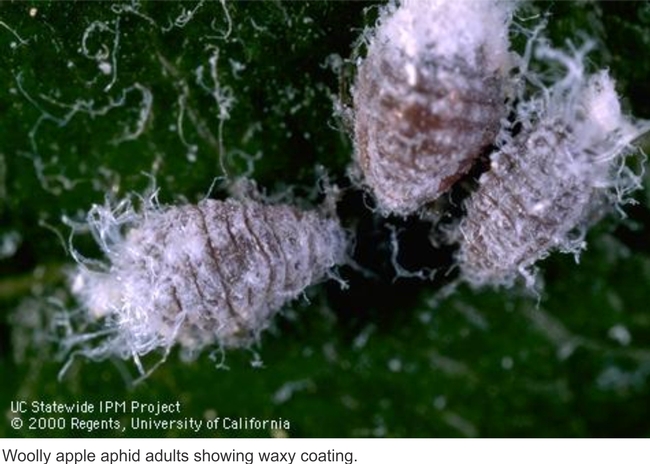
Aphids tend to be most prevalent along the upwind edge of the garden and close to other infested plants of the same species, so make a special effort to check these areas. Many aphid species prefer the underside of leaves, so turn leaves over when checking for aphids. On trees, clip off leaves from several areas of the tree. Also check for evidence of natural enemies such as lady beetles, lacewings, syrphid fly larvae, and the mummified skins of parasitized aphids. Look for disease-killed aphids as well; they may appear off color, bloated, flattened, or fuzzy. Substantial numbers of any of these natural control factors can mean the aphid population may be reduced rapidly without the need for treatment.
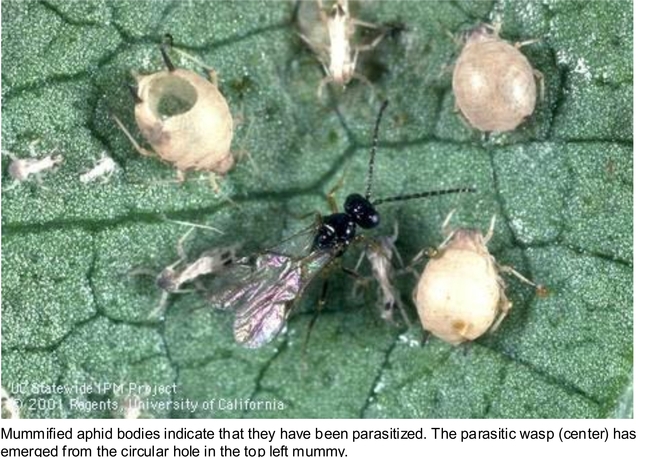
Many predators also feed on aphids. The most well known are lady beetle adults and larvae, lacewing larvae, soldier beetles, and syrphid fly larvae. Naturally occurring predators work best, especially in garden and landscape situations.
Aphids are very susceptible to fungal diseases when it is humid. These pathogens can kill entire colonies of aphids when conditions are right. Look for dead aphids that have turned reddish or brown; they'll have a fuzzy, shriveled texture unlike the shiny, bloated, tan-colored mummies that form when aphids are parasitized.
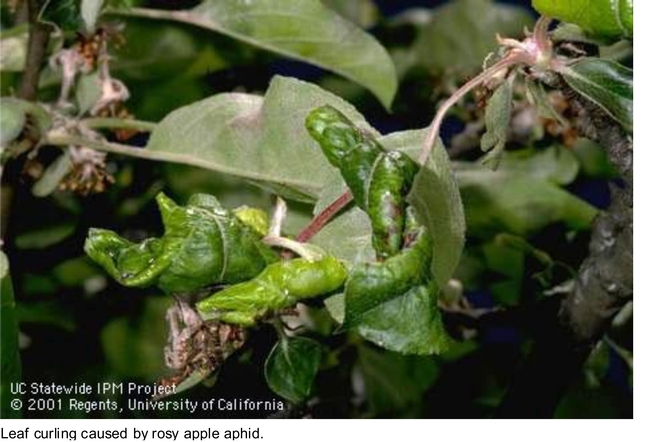
In some situations ants tend aphids and feed on the honeydew aphids excrete. At the same time, ants protect the aphids from natural enemies. If you see ants crawling up aphid-infested trees or woody plants, put a band of sticky material (e.g., Tanglefoot) around the trunk to prevent ants from climbing up. Ant stakes or containerized baits may be used on the ground to control ants without affecting aphids or their natural enemies. Prune out other ant routes.
Where aphid populations are localized on a few curled leaves or new shoots, the best control may be to prune out these areas and dispose of them. In large trees, some aphids thrive in the dense inner canopy; pruning out these areas can make the habitat less suitable.
High levels of nitrogen fertilizer favor aphid reproduction, so never use more nitrogen than necessary. Instead, use a less soluble form of nitrogen and apply it in small portions throughout the season rather than all at once. Slow-release fertilizers such as organic fertilizers or urea-based time-release formulations are best.
Grow seedlings under protective covers in the garden, in a greenhouse, or inside and then transplanting them when the seedlings are older and more tolerant of aphid feeding. Protective covers will also prevent transmission of aphid-borne viruses.
Silver-colored reflective mulches have been successfully used to reduce transmission of aphid-borne viruses in summer squash, melon, and other susceptible vegetables. These mulches repel invading aphid populations, reducing their numbers on seedlings and small plants. Another benefit is that yields of vegetables grown on reflective mulches are usually increased by the greater amount of solar energy reflecting onto leaves. When summertime temperatures get high, however, remove mulches to prevent overheating plants.
When considering whether to apply insecticides for aphid control, remember that most larger plants can tolerate light to moderate levels of aphids with little damage. Larger aphid populations often rapidly decline due to biological control or when hot temperatures arrive. Often a forceful spray of water or water-soap solution, even on large street trees, when applied with appropriate equipment, will provide sufficient control.
If insecticides are needed, insecticidal soaps and oils are the best choices for most situations. Oils may include petroleum-based horticultural oils or plant-derived oils such as neem or canola oil. These products kill primarily by smothering the aphid, so thorough coverage of infested foliage is required. These and other insecticides with contact-only activity are generally ineffective in preventing damage from aphids such as the leaf curl plum aphid or the woolly ash aphid, which are protected by galls or distorted foliage. Also, don't use soaps or oils on water-stressed plants or when the temperature exceeds 90°F.
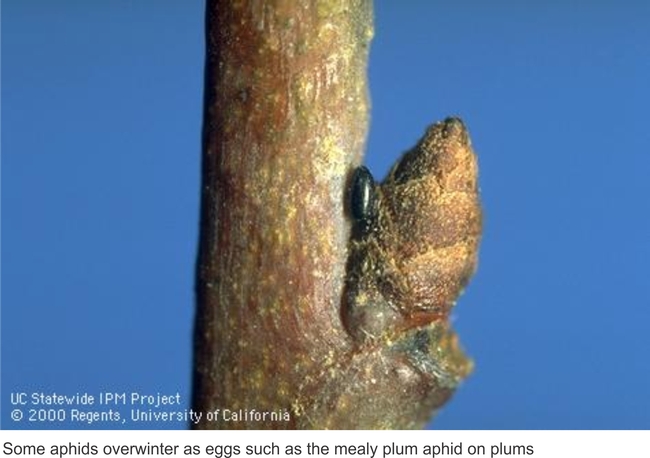
Many other insecticides are available to control aphids in the home garden and landscape, including foliar-applied formulations of malathion, permethrin, and acephate (nonfood crops only). While these materials may kill higher numbers of aphids than soaps and oils, their use should be limited, because they also kill the natural enemies that provide long-term control of aphids and other pests, and they are associated with bee kills and environmental problems. Repeated applications of these materials may also result in resistance to the material.
Systemic insecticides are also available for aphid management, primarily for woody ornamentals. These materials, including imidacloprid, are very effective and are especially useful for serious infestations of aphids such as the woolly hackberry aphid, which is often not effectively controlled by biological control or less toxic insecticides. Imidacloprid can have negative impacts on predators, parasitoids, and pollinators, so its use should be avoided where soaps and oils will provide adequate control. To protect pollinators, don't apply imidacloprid or other systemic insecticides to plants in bloom or prior to bloom. Adequate rain or irrigation is required to move the product through the soil to the roots and up into large trees, and it may take several weeks to see an effect on aphids feeding on leaves.
Go to the Master Gardener website at http://ucanr.edu/sites/ucmgnapa/ to read complete information about aphids and their control. Look for “Garden Resources,” then “Common Pest and Problems.”
Jack Kelly Clark, courtesy University of California Statewide IPM Program.
UC Master Gardeners of Napa County answer garden questions at our Help Desk on Mondays, Wednesdays, and Fridays from 9:00 a.m. - 12 noon. Free advice is given for growing conditions in Napa County.
Drop-in: UC Master Gardeners of Napa County, 1710 Soscol Avenue, Ste 4
By phone: 707-253-4143; 877-279-3065 (toll free for American Canyon/Up valley residents)
Complete the diagnosis form or e-mail mastergardeners@countyofnapa.org